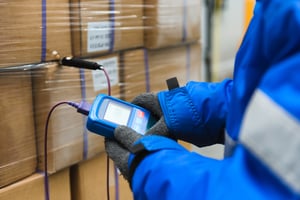Sustainability: How do Food & Grocery Supply Chains Stack Up?

Nearly 900 million people around the world are malnourished. Yet every year we waste 1.6 billion tons of food – fully a third of all the food produced globally. It's estimated to be worth US$1.2 trillion now and may grow to $1.5 trillion by 2030 if nothing is done to stop it. And if that's not scary enough, food waste is deemed responsible for eight percent of global greenhouse gases – the ones that cause global warming.[1]
Now, if we tell you that this waste is largely avoidable, and as a supply chain operations manager in the food industry you can have a significant impact, would you be interested to learn how? We thought you would.
In this paper we'll discuss the scope of the food waste problem, where it's happening, and how you can help solve the problem; while at the same time maximizing your operations to take advantage of current food industry trends[2] like:
Hyper-local sourcing
The booming desire for convenience reflected in meal kit sales and the rise of 'grocerants' (hybrid grocery store/restaurants)
Sustainability concerns
Demographic shifts
It turns out that the common basic ingredient is supply chain efficiency. Read on to learn how to bake it into your supply chain operations.
An expanding waste-line
Nobody wants to see food wasted. It's pretty distressing, in fact, to know that while piles of produce rot in one place, people go hungry somewhere else. But redistribution is not as simple as seeing a hungry child and handing her an apple.
Before we tackle how to fix the problem, let's look at some of its roots. Food waste is not the same across the globe. Research has shown that in developed countries the lion's share of spoilage takes place in the retail and consumer environment. Most of what is destroyed before being eaten is fruits and vegetables and meat products. In less-developed places most waste occurs at the production level, with fruits and veggies the primary victims of spoilage.[3]
Boston Consulting Group has identified five key drivers behind the waste problem, and three of them are supply chain related. These are:
★ Supply chain infrastructure
★ Supply chain efficiency
★ Supply chain collaboration On the infrastructure side, the application of cold-chain and temperature-controlled technology could prevent many of the losses experienced at the beginning of the food supply chain. In fact, BCG estimates that using these technologies, especially in developing countries, could cut the waste by $150 billion a year.
On the infrastructure side, the application of cold-chain and temperature-controlled technology could prevent many of the losses experienced at the beginning of the food supply chain. In fact, BCG estimates that using these technologies, especially in developing countries, could cut the waste by $150 billion a year.
To improve efficiency, digital supply chain tools can make transactions seamless, track losses and prevent waste. This area of improvement could net a $120 billion reduction in waste annually [For more information, read our recent white paper on Supply Chain Visibility].
Finally, better collaboration, among producers, suppliers and processors, through using digital tools could further reduce the waste problem by $60 billion.[4]
What's amazing is the variety of tools available to help solve these problems. From simple insulated totes that are being used in remote, developing markets to facilitate cool chain transport, to the most sophisticated tracking technologies that employ sensors and satellites, and including software-as-a-service offerings like Yard and Dock Management – such as the ones C3 Solutions offers – there are technologies at every price point and level of sophistication that can be leveraged to improve food chain efficiency.
REFERENCES:
[1] Tackling the 1.6-million-ton food loss and waste crisis, Esben Hegnsholt, Shalini Unnikrishnan, Matias Pollmann-Larsen, Bjorg Askelsdottir, and Marine Gerard, Boston Consulting Group, August 20, 2018.
[2] "What trends will shape grocery retail in 2018?", Katy Askew, FoodNavigator.com, December 18, 2017.
[3] Tackling the 1.6-million-ton food loss and waste crisis, Esben Hegnsholt, Shalini Unnikrishnan, Matias Pollmann-Larsen, Bjorg Askelsdottir, and Marine Gerard, Boston Consulting Group, August 20, 2018.
[4] BCG, ibid.

